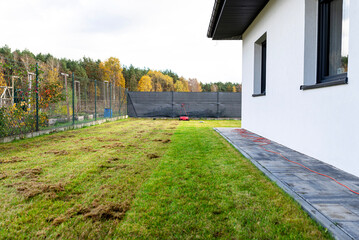Last Updated on October 4, 2024 by Dan
A healthy lawn is not just a visual asset; it contributes to the environment by filtering air and water, providing habitat for wildlife, and enhancing property value. However, many homeowners struggle with patchy, thin grass that detracts from their outdoor space. Two key practices that can transform a struggling lawn into a lush paradise are aeration and overseeding. This article will guide you through these processes, helping you achieve a vibrant lawn.
Understanding Lawn Health
Importance of Lawn Care
A well-maintained lawn offers numerous benefits, including aesthetic appeal, improved air quality, and a space for outdoor activities. Healthy grass can also reduce soil erosion and help regulate temperature.
Common Lawn Problems
Patchy areas and thinning grass can arise from various issues, including soil compaction, poor soil quality, and pest infestations. Recognizing these problems is the first step toward a healthier lawn.
The Aeration Process
What is Aeration?
Aeration involves creating small holes in the soil to relieve compaction and enhance the flow of air, water, and nutrients to the grass roots. This process is essential for promoting healthy growth and resilience in your lawn.
Benefits of Aeration
- Reduces soil compaction: Compacted soil restricts root growth and nutrient uptake.
- Improves water and nutrient absorption: Aeration allows essential elements to penetrate deeper into the soil.
- Enhances root growth: With better access to nutrients, roots can grow stronger and deeper.
When to Aerate
The best times to aerate depend on your grass type. For cool-season grasses, early spring or fall is ideal, while warm-season grasses benefit from aeration in late spring or early summer.


How to Aerate Your Lawn
- Gather tools: Use a core aerator, lawnmower, and garden hose.
- Prepare your lawn: Mow to the recommended height and water the day before aeration to soften the soil.
- Aerate: Use a crisscross pattern to ensure thorough coverage. Leave the soil plugs on the lawn to decompose and enrich the soil.
The Overseeding Process
What is Overseeding?
Overseeding is the practice of spreading grass seed over an existing lawn to fill in bare spots and improve overall density.
Benefits of Overseeding
- Fills in bare spots: Helps create a uniform appearance.
- Improves lawn density and color: Thicker grass is healthier and more vibrant.
- Enhances resistance to pests and diseases: A robust lawn can better withstand environmental stressors.
When to Overseed
Similar to aeration, overseeding should be done during the growing season. For cool-season grasses, early fall is optimal, while warm-season grasses should be overseeded in late spring.
How to Overseed Your Lawn
- Prepare the lawn: Mow short and remove clippings.
- Apply fertilizer: Use a starter fertilizer to promote seed growth.
- Spread the seed: Use a broadcast spreader for even distribution.
- Water regularly: Keep the soil moist until the new grass is established.
Combining Aeration and Overseeding
Why Aerate Before Overseeding?
Aeration creates ideal conditions for overseeding by allowing seeds to make direct contact with the soil, enhancing germination rates and establishment.
Creating a Comprehensive Lawn Care Plan
Integrate aeration and overseeding into your regular lawn maintenance routine. Consider seasonal factors and follow-up care, such as watering and fertilizing.
Troubleshooting Common Issues
Addressing Poor Germination
Factors like inadequate watering, poor seed quality, and soil compaction can hinder germination. Ensure proper care and conditions for optimal results.
Dealing with Weeds
Preventative measures include applying pre-emergent herbicides before overseeding and maintaining a thick lawn to outcompete weeds.
Maintaining Your Newly Overseeded Lawn
Water the lawn every few days and avoid heavy foot traffic for a couple of weeks to allow the new grass to establish.
Final thoughts
Aeration and overseeding are vital practices for transforming a patchy lawn into a lush, green oasis. By following the steps outlined in this article, homeowners can achieve a healthier lawn that enhances their outdoor space.
Share your lawn care experiences or ask questions in the comments below. Subscribe for more tips and advice on maintaining a beautiful lawn!

